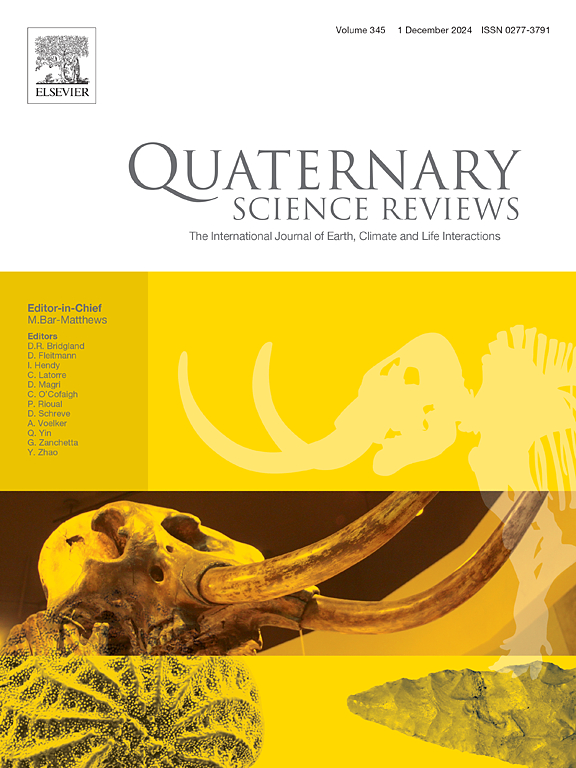Dating fluvial terraces on the southeastern Tibetan Plateau using the uranium comminution age method
IF 3.2
1区 地球科学
Q1 GEOGRAPHY, PHYSICAL
引用次数: 0
Abstract
Fluvial incision plays a crucial role in shaping regional landscapes, reflecting the dynamic interplay between tectonic forces and climate fluctuations. Accurate dating of fluvial terraces, which record both aggradation and incision processes, is essential for understanding the evolution of drainage systems. However, conventional dating methods such as radiocarbon (14C), optically stimulated luminescence (OSL), and cosmogenic radionuclide (CRN) techniques face limitations, particularly for terraces outside their optimal ranges or those with complex burial histories. This study introduces a novel approach based on the recoil loss of 234U from particle surfaces following fragmentation from bedrock, enabling the dating of silt terrace sediments without the need for well-buried or sorted samples. We apply this approach to terrace sequences along the Lancang and Jinsha rivers on the southeastern fringe of the Tibetan Plateau, an area that has been extensively studied for its geomorphology and sedimentology to investigate fluvial responses to tectonic and climatic drivers. Our results reveal a consistent decrease in 234U/238U ratios with increasing terrace height, approaching equilibrium values. The deposition ages derived from this method closely align with K-feldspar post-infrared infrared stimulated luminescence (pIRIR) ages from the Lancang River and show a positive correlation with electron spin resonance (ESR) ages from the Jinsha River. Based on the terrace ages presented here, we estimate long-term incision rates of 0.46 mm/yr for the Lancang River and 0.31 mm/yr for the Jinsha River since the middle Pleistocene. These findings underscore the potential of the uranium comminution age method as an effective tool for dating fluvial terrace deposits, providing an additional dating method to conventional dating techniques.
用铀粉碎年龄法测定青藏高原东南部河流阶地的年代
河流切割对区域景观的形成起着至关重要的作用,反映了构造力与气候波动之间的动态相互作用。河流阶地既记录了沉积过程,也记录了切割过程,对了解流域系统的演化至关重要。然而,传统的测年方法,如放射性碳(14C)、光激发发光(OSL)和宇宙生成放射性核素(CRN)技术面临局限性,特别是对于超出其最佳范围或具有复杂埋藏历史的阶地。这项研究引入了一种新的方法,该方法基于基岩破碎后颗粒表面234U的反冲损失,使得淤泥阶地沉积物的年代测定无需埋藏良好或分类的样品。我们将这一方法应用于青藏高原东南边缘澜沧江和金沙江的阶地序列,该地区的地貌和沉积学已经得到了广泛的研究,以研究河流对构造和气候驱动因素的响应。我们的研究结果显示,随着梯田高度的增加,234U/238U比率持续下降,接近平衡值。该方法测定的沉积年龄与澜沧江k长石红外后红外激发发光(pIRIR)年龄吻合较好,与金沙江电子自旋共振(ESR)年龄呈正相关。根据阶地年龄,我们估计澜沧江自中更新世以来的长期切割速率为0.46 mm/yr,金沙江为0.31 mm/yr。这些发现强调了铀粉碎年龄法作为一种有效的河流阶地沉积物测年工具的潜力,为传统测年技术提供了一种额外的测年方法。
本文章由计算机程序翻译,如有差异,请以英文原文为准。
求助全文
约1分钟内获得全文
求助全文
来源期刊

Quaternary Science Reviews
地学-地球科学综合
CiteScore
7.50
自引率
15.00%
发文量
388
审稿时长
3 months
期刊介绍:
Quaternary Science Reviews caters for all aspects of Quaternary science, and includes, for example, geology, geomorphology, geography, archaeology, soil science, palaeobotany, palaeontology, palaeoclimatology and the full range of applicable dating methods. The dividing line between what constitutes the review paper and one which contains new original data is not easy to establish, so QSR also publishes papers with new data especially if these perform a review function. All the Quaternary sciences are changing rapidly and subject to re-evaluation as the pace of discovery quickens; thus the diverse but comprehensive role of Quaternary Science Reviews keeps readers abreast of the wider issues relating to new developments in the field.
 求助内容:
求助内容: 应助结果提醒方式:
应助结果提醒方式:


